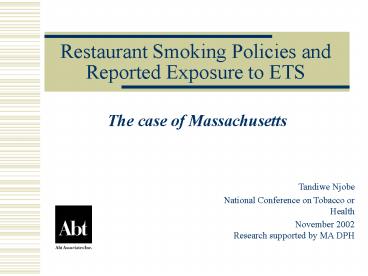Restaurant Smoking Policies and Reported Exposure to ETS - PowerPoint PPT Presentation
1 / 18
Title:
Restaurant Smoking Policies and Reported Exposure to ETS
Description:
... ordinance data by town of residence and time period of interview ... Status of restaurant ordinance in home town. Ordinance in effect at time of interview = 1 ... – PowerPoint PPT presentation
Number of Views:21
Avg rating:3.0/5.0
Title: Restaurant Smoking Policies and Reported Exposure to ETS
1
Restaurant Smoking Policies and Reported Exposure
to ETS
- The case of Massachusetts
Tandiwe Njobe National Conference on Tobacco or
Health November 2002 Research supported by MA DPH
2
Introduction
- Question Do local restaurant smoking ordinances
reduce the likelihood of exposure to ETS (for
Massachusetts residents) when dining out?
3
Background to Analysis
- Exposure to ETS is known to have adverse health
impacts - Studies show patrons and restaurant workers to be
disproportionately affected by exposure to ETS - Support for smoke free restaurants is growing in
Massachusetts - Few studies address the extent to which
ordinances reduce exposure to ETS
4
The Massachusetts Context
- Policies restricting exposure are enacted at the
town level - Local Boards of Health funded by MTCP identify
and support the enactment of tobacco control
policies - By June 2001, 182 towns (out of 351) representing
78 of MA population had a restaurant ordinance
in effect
5
Data Sources
- Massachusetts Adult Tobacco Survey (MATS)
- Random digit dial survey
- (Center for Survey Research, UMASS Boston)
- Includes fiscal years 1995 2000
- n 13,000
- MTCP Ordinance Tracking System
- Data on 26 types of ordinance provisions for 351
towns (July 1993 June 2000)
6
Methods
- Individual level analysis
- Demographics and household characteristics
- Individuals home town ordinance situation
- Survey respondents mapped to ordinance data by
town of residence and time period of interview - 14 six month time periods
- Ordinances coded as being in effect for a time
period if in existence for at least 3 out of 6
months
7
Methods continued.
- Dependent variable derived from the following
survey question - When you eat out in restaurants how often are
you exposed to other peoples tobacco smoke? - Always
- Often
- Sometimes
- Rarely
- Never
8
Methods continued
- Covariates
- Demographics (age, race, gender, education)
- Smoker or not
- Frequency of dining out
- Children under 12 in the household
- Number of restaurants in respondents town (2001)
- Time
9
Ordinances Predictor Variable of Interest
- Status of restaurant ordinance in home town
- Ordinance in effect at time of interview 1
- No ordinance in effect at time of interview 0
- Status of restaurant ordinances in other towns in
the state - Percentage of towns in the state covered by an
ordinance at the time of the interview.
10
Model
- Estimated 2 models in SUDAAN to account for
complex sample design - Model 1 Ordered logit specification
- 5 categories for dependent variable
- More sensitive measure of exposure
- Harder to interpret coefficients
11
Model
- Model 2 Dichotomous logit model specification
- 2 categories for dependent variable (yes/no)
- 5 categories collapsed as follows
- Always/ Often/ Sometimes coded Yes 1
- Rarely/ Never coded No 0
- Less sensitive measure of exposure
- Easier to interpret coefficients
12
Results/ Findings
- The presence of a restaurant ordinance in a town
reduces the likelihood of exposure to ETS in
restaurants of that town. - The presence of restaurant ordinances elsewhere
in the state may reduce the likelihood of
exposure to ETS in restaurants (marginally
significant).
13
Results/ Findings continued..
VARIABLE OF INTEREST COEFFICIENT (ordered logit specification) ODDS RATIO (dichotomous specification)
Home Ordinance -0.2283 (p lt 0.001) 0.8332 (0.7106 0.9769)
State Ordinance -1.1634 (p lt 0.10) 0.3432 (0.0791 1.4888)
14
Results/ Findings continued..
- Demographics
- Age Older people less likely to report exposure
than people under 25 years - Race Racial/ ethnic minorities reported less
exposure than non Hispanic Whites - Education Gender Differences not
statistically significant - Time
- Reduced exposure over time
15
Results/ Findings continued..
- Other respondent level variables
- High frequency of dining out greater likelihood
of reported exposure compared to residents who
eat out less than one a month - Smokers More likely to report exposure than
non-smokers - Children Number of restaurants Not
significantly related to exposure
16
Discussion
- Local restaurant smoking restrictions lead to
lower reported levels of exposure to ETS in
restaurants - Prior research shows MTCP funding to be strongly
correlated with ordinance enactment - MTCP funding stimulates ETS ordinance adoption
which leads to reduced exposure to ETS
17
Discussion continued
- Ordered logit versus dichotomous logit
- Consistent message is that ordinances have the
effect of reducing risk of exposure - State ordinance term is marginally significant
- Improve specification by including distance
- Ordinance duration -- effect of ordinance not
significantly increased by length of time it has
been in existence - Limited testing -- specification may be weak.
18
For more information contact
- Tandiwe Njobe
- Abt Associates Inc.
- 55 Wheeler Street
- Cambridge, MA 02138-1168
- Email Tandiwe_Njobe_at_abtassoc.com
- Analysis will be published in 2002 Annual Report
on Independent Evaluation of the Massachusetts
Tobacco Control Program































